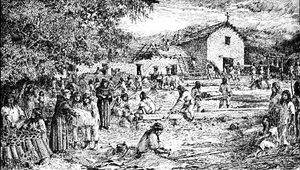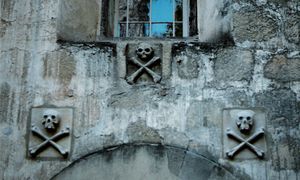Mission Santa Barbara/Gallery: Difference between revisions
Jump to navigation
Jump to search

imported>Robert A. Estremo (Created page with "{{subpages}} <gallery perrow=3 widths=300px heights=250px> Image:Cemetery Entrance.jpg|{{Cemetery Entrance.jpg/credit}}<br />Stone "skull and crossbone" carvings denote the ceme...") |
imported>Robert A. Estremo No edit summary |
||
| Line 2: | Line 2: | ||
<gallery perrow=3 widths=300px heights=250px> | <gallery perrow=3 widths=300px heights=250px> | ||
Image:Building a Mission.jpg|{{Building a Mission.jpg/credit}}<br />Construction of the first Santa Bárbara mission. | |||
Image:Cemetery Entrance.jpg|{{Cemetery Entrance.jpg/credit}}<br />Stone "skull and crossbone" carvings denote the cemetery entrance at Mission Santa Barbara. Actual skulls and bones were long used to mark the entrances to Spanish cemeteries (''campo santos''). The practice, dating back many centuries, led to the symbol eventually becoming associated with the concept of death. | Image:Cemetery Entrance.jpg|{{Cemetery Entrance.jpg/credit}}<br />Stone "skull and crossbone" carvings denote the cemetery entrance at Mission Santa Barbara. Actual skulls and bones were long used to mark the entrances to Spanish cemeteries (''campo santos''). The practice, dating back many centuries, led to the symbol eventually becoming associated with the concept of death. | ||
</gallery> | </gallery> | ||
Revision as of 00:39, 15 November 2012
(CC) Photo: Robert A. Estremo
Stone "skull and crossbone" carvings denote the cemetery entrance at Mission Santa Barbara. Actual skulls and bones were long used to mark the entrances to Spanish cemeteries (campo santos). The practice, dating back many centuries, led to the symbol eventually becoming associated with the concept of death.

